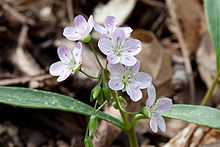Claytonia virginica
| Claytonia virginica | |
|---|---|
 | |
| Eastern spring beauty at Radnor Lake | |
| Conservation status | |
| Scientific classification | |
| Kingdom: | Plantae |
| (unranked): | Angiosperms |
| (unranked): | Eudicots |
| (unranked): | Core eudicots |
| Order: | Caryophyllales |
| Family: | Portulacaceae |
| Genus: | Claytonia |
| Species: | C. virginica |
| Binomial name | |
| Claytonia virginica L. | |
Claytonia virginica (L.), the Eastern spring beauty, Virginia spring beauty, or fairy spud, is an herbaceous perennial in the family Portulacaceae. Its native range is Eastern North America.[1] Its scientific name honors Colonial Virginia botanist John Clayton (1694–1773).
Description
Spring beauty is a perennial plant, overwintering through a corm. It is a trailing plant growing to 5–40 cm long. The leaves are slender lanceolate, 3–14 cm long and 0.5–1.3 cm broad, with a 6–20 cm long petiole.
The flowers are 0.7–1.4 cm diameter with five pale pink or white (rarely yellow) petals,[2] and reflect UV light.[3] It has a raceme inflorescence, in which its flowers branch off of the shoot. The individual flowers bloom for three days, although the five stamens on each flower are only active for a single day.[4] Flowering occurs between March and May depending on part of its range and weather. The seeds are between 0.2-0.3 cm in diameter and a shiny black.[5] The seeds are released from the capsule fruit when it breaks open.[6] An elaiosome is present on the seeds and allow for ant dispersal.[7]
It is also a polyploid, having 2n between 12 and 191 chromosomes. The largest number of chromosomes was observed in New York City.[8]
Habitat and range
Spring beauty is found in the Eastern temperate deciduous forest of North America[9] It is noted for its abundance throughout many parts of its range, especially in forests. The plant can be found throughout many different habitat types including lawns, city parks, forests, roadsides, wetlands, bluffs, and ravines.[10]
Uses
This plant has been used medicinally by the Iroquois, who would give a cold infusion or decoction of the powdered roots to children suffering from convulsions.[11] They would also eat the raw roots, believing that they permanently prevented conception.[12] They would also eat the roots as food,[13] as would the Algonquin people, who cooked them like potatoes.[14] Spring beauty corms along with the entire above ground portion of the plant are safe for human consumption.[15]
References
- ↑ USDA Plants, http://plants.usda.gov/java/profile?symbol=CLVI3
- ↑ Claytonia virginica, Flora of North America, http://www.efloras.org/florataxon.aspx?flora_id=1&taxon_id=220002996
- ↑ Schemske, D., M. Willson, M. Melampy, L. Miller, L. Verner, K. Schemske, L. Best. 1978. Flowering ecology of some spring woodland herbs. Ecology. 59(2): 351-366
- ↑ Schemske, D., M. Willson, M. Melampy, L. Miller, L. Verner, K. Schemske, L. Best. 1978. Flowering ecology of some spring woodland herbs. Ecology. 59(2): 351-366
- ↑ Claytonia virginica, Flora of North America, http://www.efloras.org/florataxon.aspx?flora_id=1&taxon_id=220002996
- ↑ Schemske, D., M. Willson, M. Melampy, L. Miller, L. Verner, K. Schemske, L. Best. 1978. Flowering ecology of some spring woodland herbs. Ecology. 59(2): 351-366
- ↑ Claytonia virginica, Flora of North America, http://www.efloras.org/florataxon.aspx?flora_id=1&taxon_id=220002996
- ↑ Cytogeography of Claytonia virginica and its allies, http://www.jstor.org/stable/2395001?seq=1
- ↑ USDA Plants, http://plants.usda.gov/java/profile?symbol=CLVI3
- ↑ Claytonia virginica, Flora of North America, http://www.efloras.org/florataxon.aspx?flora_id=1&taxon_id=220002996
- ↑ Herrick, James William 1977 Iroquois Medical Botany. State University of New York, Albany, PhD Thesis (p. 317)
- ↑ Herrick, p.318
- ↑ Waugh, F. W. 1916 Iroquis Foods and Food Preparation. Ottawa. Canada Department of Mines (p. 120)
- ↑ Black, Meredith Jean 1980 Algonquin Ethnobotany: An Interpretation of Aboriginal Adaptation in South Western Quebec. Ottawa. National Museums of Canada. Mercury Series Number 65 (p. 84)
- ↑ Thayer, Samuel (2006). The Forager's Harvest. w5066 State Hwy 86 Ogema, WI 54459: Forager's Harvest. pp. 193–199. ISBN 0976626608.
External links
| Wikimedia Commons has media related to Claytonia virginica. |
| Wikiversity has bloom time data for Claytonia virginica on the Bloom Clock |
- Flora of North America: Claytonia virginica
- Missouri Plants: Claytonia virginica
- Virginia Native Plant Society: Claytonia virginica
- Connecticut Botanical Society: Claytonia virginica
- Missouri Botanical Gardens: Claytonia virginica
